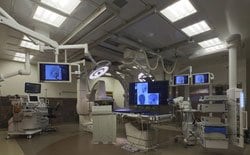Alteplase
Alteplase is the only FDA-approved drug for the treatment of acute ischemic strokes. It is considered the first line of treatment for acute ischemic stroke but it must be administered within a 4.5-hour window from the onset of symptoms to work best. Alteplase is administered into the vein, usually in the arm, then the medication travels through the blood stream until it reaches the blockage.The medication then works to dissolve the clot.
Alteplase is often referred to as the "clot buster" for its ability to dissolve blockages in blood vessels and restore blood flow in the brain.
If patients are not candidates for Alteplase or do not arrive within 4½ hours may still benefit from specialized procedures to remove the blood clots in the brain, clear its delicate blood vessels of blockages and repair other cerebrovascular abnormalities.
Anticoagulant and Antiplatelet Medicines
Anticoagulants and antiplatelets are medicines that help treat or prevent blood clots and can help prevent serious medical problems, like heart attack or stroke.
Normally, blood clotting keeps the body from losing too much blood from wounds. However, blood clots in your blood vessels can cause problems if they block the flow of blood, oxygen, and nutrition to a part of your body.
Some clots may form in the heart or the brain. Others may form somewhere else, like the leg, and then travel to another part of the body, like a lung.
You may be at higher risk for blood clots if you:
- Have had a heart attack or stroke
- Have an artificial heart valve
- Have a certain kind of irregular heartbeat
- Have a blood problem that makes your blood clot too easily
- Are on bed rest for a long time, like a
- Have had certain types of surgery
These medicines may be given into a vein (IV), as a shot just under the skin, or as a tablet you take by mouth. The right amount and type of anticoagulant or antiplatelet can prevent many problems.
Statin Medicines
Statins are a group of medicines used to lower cholesterol. Lowering your cholesterol can lower your risk of heart disease, heart attack, and stroke. Diet and exercise can also lower cholesterol but sometimes not enough. Statins may be used alone or with other medicines, usually when changes in your diet and exercise have not lowered your cholesterol level.
Endovascular treatments are a collection of very effective, minimally invasive procedures that treat and aid in the diagnosis of cerebrovascular conditions.
Thrombectomy
A thrombectomy is a surgical procedure used to remove a blood clot (thrombus) from a vessel. The thrombus blocks blood flow and may cause a stroke if the circulation is not restored promptly. If you have an ischemic stroke (stroke caused by a blood clot in your brain) doctors can sometimes do a procedure called a thrombectomy to remove the clot.
A doctor threads a catheter (thin, hollow tube) through an artery in your groin up to your brain. Once the catheter is in place, the doctor uses a tiny mechanical device to break up or remove the clot.
Among the innovative endovascular procedures our specialists perform are:
- Clot retrieval devices
- Carotid angioplasty for carotid stenosis
- Embolization and coiling of aneurysms
- Balloon angioplasty for vasospasm
- Intra-arterial medications for vasospasms
 St. Cloud Hospital's endovascular operating room is the first of its kind in Central Minnesota and is used to perform complex heart and vascular procedures. Its advanced imaging technology can scan patient's vascular anatomy and reconstruct it into 3D images.
St. Cloud Hospital's endovascular operating room is the first of its kind in Central Minnesota and is used to perform complex heart and vascular procedures. Its advanced imaging technology can scan patient's vascular anatomy and reconstruct it into 3D images.
Learn more about our stroke/vascular neurology services.